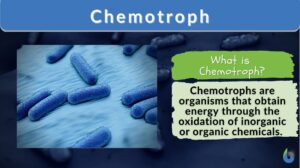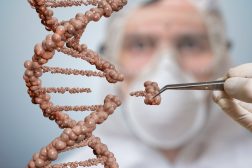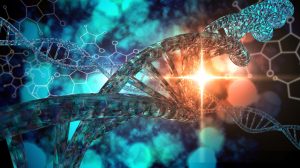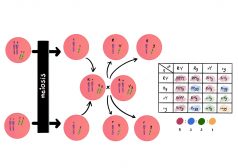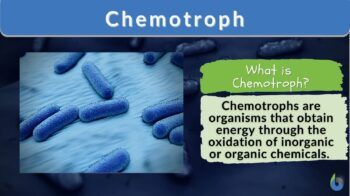
Chemotroph
n., plural: chemotrophs
/ˈkiːmoʊˌtroʊf/
Definition: An organism deriving energy by chemically breaking down compounds
Table of Contents
Chemotroph Definition
A chemotroph refers to an organism that obtains energy mainly from carbon dioxide and from other inorganic sources as well as organic compounds through a process called chemosynthesis. Chemosynthesis is carried out by chemotrophs through the oxidation of electron donors in the environment. It is a process by which these organisms use chemical energy to synthesize organic compounds (e.g., carbohydrates) by utilizing inorganic compounds such as carbon dioxide, hydrogen sulfide, sulfur, ammonium, and ferrous iron as reducing agents.
Many bacteria and archaea are chemotrophic, especially those that thrive in deep seas and oceans. Their role in the ecosystem is essential as they provide a source of organic carbon for other organisms in the food chain, especially in ecosystems where light is limited (e.g., certain species of worms and snails in deep-seas hydrothermal vent communities, detritivores, and filter feeders in water columns).
Etymology: The term “chemotroph” is derived from the Greek words “chemo” (meaning chemical) and “troph” (meaning nourishment), signifying organisms that feed on chemicals.
Synonym: chemosynthetic organism
Compare: phototroph
See also: autotroph
Autotrophs vs Heterotrophs and Chemotrophs vs Phototrophs Introduction Biology Metabolism MCAT (by Science Simplified):
Types of Chemotrophs
Chemotrophs may be chemoautotrophs or chemoheterotrophs.
- Chemoautotrophs are autotrophs. This means they are capable of making their own food through chemosynthesis. Chemoautotrophs are found in hostile habitats such as deep sea vents and where light cannot easily penetrate through. They include the methanogens, halophiles, nitrifiers, thermoacidophiles, sulfur oxidizers, etc.
- Chemoheterotrophs are chemotrophs that are heterotrophic organisms. They are not capable of fixing carbon to form their own necessary organic compounds. They may be further classified as chemolithoheterotrophs or chemoorganoheterotrophs.
- Chemolithoheterotrophs are those that utilize inorganic energy sources as electron donors for energy production. They are capable of metabolizing substances, such as hydrogen sulfide, iron, and sulfur. Example: sulfur-oxidizing bacteria, which oxidize inorganic sulfur compounds to synthesize organic molecules.
- Chemoorganoheterotrophs are those using organic sources to produce energy through oxidation. They break down organic carbon sources, e.g., sugars and organic acids. Examples: Escherichia coli, Staphylococcus aureus, Mycobacterium tuberculosis, Pseudomonas aeruginosa, Clostridium species, Klebsiella pneumoniae
Mechanisms Of Energy Production
Chemosynthesis is a process used by microorganisms to convert inorganic compounds into organic molecules. It is the prevalent process of generating energy in environments where light is scarce, such as deep-sea hydrothermal vents, but it can also take place in other ecosystems. Chemotrophs in deep-sea vents, in particular, capture inorganic compounds released from the crust along with hot, mineral-laden water. From these inorganic compounds, chemotrophs are deriving energy by subjecting these compounds to chemical reactions. Here are ways by which chemotrophs obtain energy:
- Chemiosmotic processes: by pumping protons across the membrane to establish a proton gradient, which is used to drive ATP synthesis
- Electron transport chains: electrons are transferred from electron donors (inorganic chemicals or organic compounds) to electron acceptors, facilitating the generation of a proton motive force, which, in turn, powers ATP production.
Using the energy generated and the carbon captured from carbon dioxide, chemotrophs synthesize organic molecules, such as sugars, amino acids, and lipids, which they can later use to fuel their growth and reproduction.
NOTE IT!
Deep-sea chemotrophs, such as extremophiles, live in remote, hydrothermal vent ecosystems. Despite the lack of sunlight penetrating the deep seas, these microbes are able to flourish by utilizing chemicals from the Earth’s crust to produce energy through chemical reactions. This could imply that life beyond Earth could be possible on celestial bodies, such as Mars and Europa (Jupiter’s moon), where subsurface brines could potentially support chemotrophic life. It’s an enticing thought to ponder that we are not alone in the universe as there could be chemotrophic life out there in the dark depths of neighboring celestial bodies.
References
- Madigan, M. T., Bender, K. S., Buckley, D. H., & Sattley, W. M. (2018). “Brock Biology of Microorganisms” (15th ed.). Pearson.
- Silver, S., & Phung, L. T. (2005). “Genes and enzymes involved in bacterial oxidation and reduction of inorganic arsenic.” Applied and Environmental Microbiology, 71(2), 599-608.
- Widdel, F., & Bak, F. (1992). “Gram-negative mesophilic sulfate-reducing bacteria.” In Balows A., Trüper H.G., Dworkin M., Harder W., Schleifer K.H. (Eds.), “The Prokaryotes” (2nd ed., Vol. 4, pp. 3352-3378). Springer.
©BiologyOnline.com. Content provided and moderated by Biology Online Editors.
